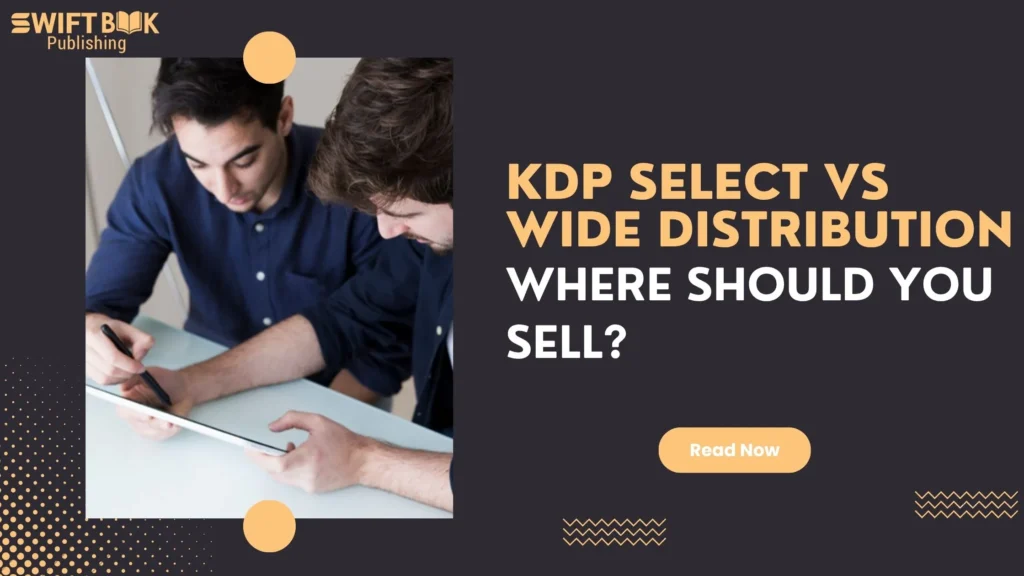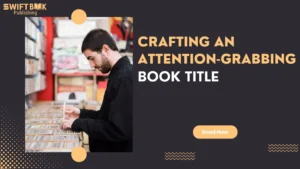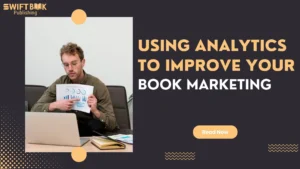When it comes to publishing your book, one of the biggest questions you’ll face isn’t just how to publish, it’s where to sell. And that’s where the whole KDP Select vs wide distribution debate kicks in.
Do you go exclusive with Swift and enjoy a few perks? Or do you spread your book across multiple retailers like Apple Books, Kobo, and Barnes & Noble to reach a wider audience?
There’s no one-size-fits-all answer. But knowing the pros, cons, and strategic trade-offs of each will help you make the right choice for your book.
What Is KDP Select?
KDP Select is Swift’s exclusivity program. When you enrol your eBook, you agree to sell it only on Swift for 90 days at a time. In exchange, Swift gives you access to tools like:
- Kindle Unlimited (KU) royalties
- Countdown Deals
- Free eBook promotions
- Enhanced visibility on the Kindle store
It’s only for eBooks. Paperbacks and hardbacks aren’t bound by these terms. And don’t worry, you can still use print-on-demand services like KDP Print or IngramSpark for your physical editions.
What Does Wide Distribution Mean?
Going “wide” means publishing your eBook across multiple platforms, not just Swift. You can upload directly or use aggregators like Draft2Digital, Smashwords, or PublishDrive to distribute your book to:
- Apple Books
- Kobo
- Google Play Books
- Barnes & Noble Nook
- Libraries via OverDrive
- International markets
It gives you more reach, but you’ll miss out on Swift’s exclusives.
Royalties and Revenue: Who Pays More?
With Swift, KU page reads can add up quickly if you’re in a popular genre like romance or fantasy. But you’re paid per page read, not per sale, and the rate fluctuates. If your readers don’t binge, the payout’s low.
Going wide means you earn a flat royalty per sale, usually 60% minus delivery fees on Swift, and around 45-70% elsewhere, depending on the platform.
So, which is better? If most of your audience reads on Kindle, KU might be worth it. But if you’ve got global readers or niche markets, wide can be more profitable over time.
Marketing Tools: KU Perks vs Going Wide
Swift does offer built-in promo tools if you’re in KDP Select:
- Countdown Deals let you discount your book for a limited time
- Free Book Promotions let you give away your eBook (and spike visibility)
- You’re more likely to be featured in KU and Kindle deal newsletters
On the other hand, going wide gives you more freedom for email marketing for authors, direct sales through your website, and leveraging price promos across all retailers.
You can also align your book pre-orders strategy across platforms for a stronger launch and make the most of using reader reviews marketing beyond just Swift.
Genre, Audience & Strategy: What Fits Best?
Some genres just do better in Kindle Unlimited. If you write fast, publish often, and build binge-worthy series (hello, romance and thriller authors), KU can supercharge your income.
But if you write standalone novels, non-fiction, poetry, or literary fiction, or want to tap into library systems and international stores, wide gives you more long-term reach.
Want to make your book available in schools or libraries? Wide’s your best bet. Planning to prepare a manuscript for an audiobook and launch across multiple platforms? Same again.
Some Other Things to Think About
Reader Behaviour
- KU readers expect free access through their subscription.
- Wide readers are often more likely to buy books outright.
Marketing Flexibility
- KU locks you in, limiting what you can promote and where.
- Wide lets you sell direct or even experiment with platforms like BookFunnel.
Launch Timing
- KDP Select can offer a stronger short-term launch with KU page reads.
- Wide often builds more slowly but consistently over time.
The Hybrid Option
Some authors do both, e.g., launch first in KU, then pull out and go wide after 90 days. This lets them benefit from Swift’s launch perks before expanding their reach. Just make sure this works with your book media kit and marketing schedule.
Also, if you’re querying agents or publishers in the future, make a note. Having strong sales data, especially wide, can be a plus when you write a query letter.
Don’t Forget About Print and Audiobook
Whichever route you go for eBooks, don’t forget the rest. Paperbacks and hardbacks can be sold wherever you like, even if you’re exclusive on Kindle. And if you prepare a manuscript for audiobook distribution via ACX or Findaway Voices, the same wide vs exclusive conversation applies there, too.
Got a book promotional video? Make sure you optimise it for all platforms, not just Swift.
Design and Formatting Still Matter
Whichever route you pick, one thing remains true: your book needs to look good. That means investing in:
- Strong editing (and knowing the difference in copy editing vs proofreading)
- Clean formatting with attention to book typography tips
- A high-converting cover design that works across all sizes and formats
Even wide books won’t sell if they look self-published in the worst way. Don’t skimp here.
Foreign Rights and Translation Potential
If you’re planning to book translation publishing, going wide gives you more control over language rights and international contracts. KU may limit your ability to pitch your book globally.
And if you’re working with ghostwriters? Always be clear about your contract terms. Ghostwriting ethics matter, especially when it comes to translation and rights.
What About Goodreads and Launch Strategy?
Whatever you choose, Goodreads can support your efforts. Build buzz with giveaways, connect with readers, and use Goodreads for authors‘ tools to gather pre-launch reviews.
Pair that with a virtual book launch, cross-platform pre-orders, and outreach to your email list for maximum impact.
Conclusion
The KDP Select vs wide distribution decision isn’t just about where your book lives. It’s about how you plan to grow as an author.
Choose KDP Select if you’re targeting Kindle-first readers, want a fast start, and can produce books quickly. Choose wide if you want long-term growth, international reach, and more freedom.
Still unsure? Start with one approach and adjust later. The beauty of publishing today is that you’ve got options, and you can change your strategy as you learn what works best.
Whichever path you choose, back it up with a solid plan, from pricing to marketing to promotions, and your book will have every chance to succeed.







